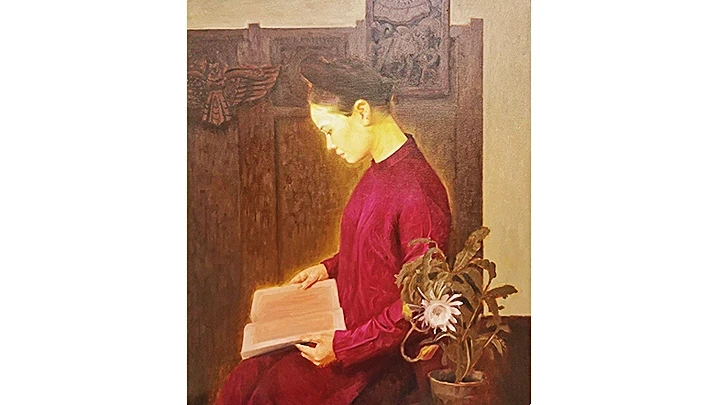Vitality towards mobilising community
The project, undertaken by the Heritage and Art (H&A) group—founded by painter Nguyen Minh (Minh Pho)—aims to inherit, preserve, and promote Vietnamese cultural heritage. Since early 2024, activities such as meetings with art and cultural experts, and studies of ancient art and national treasures at the Vietnam Fine Arts Museum have been launched.
Sixteen artists from various disciplines, including painting, graphic design, and sculpture, with materials ranging from metal, oil paint, and silk, to lacquer and ceramics, are creating works under a common theme in their unique styles. Nguyen Minh, the group’s leader, shared that this year, the group is focusing on national heritage and treasures. They have also organised field trips across different regions to gather additional resources.
Under the project, exchanges and joint painting sessions on the theme of heritage will be held with artists. A programme titled "Heritage through the eyes of children" will introduce young participants to the artefacts, encouraging them to express their interpretations through arts with guidance from professional artists. Associate Professor Dr Bui Hoai Son, a permanent member of the National Assembly's Committee for Culture and Education, remarked that the project's theme is highly relevant today. As today’s generation seeks to connect with the past, an ethical responsibility is needed to preserve the values the ancestors worked hard to cultivate. Understanding leads to appreciation, which fosters a desire to practice and pass on these values to future generations. Ancient artefacts will continue to have a new life in society through the creativity of artists, which is crucial because living artefacts that are dynamically presented can engage the entire society.
 |
'Truc chi' (bamboo pulp paper) work titled “Kinnaras”. (Photo: CAO PHUONG THAO) |
Three-party collaboration for success
The theme "Ancient fine arts and national treasures" has inspired the 16 artists in the group. The exhibition "Once Upon a Time" at the Exhibition House at 29 Hang Bai Street in Hanoi, featuring 39 works, marked the project's initial success. Notable works include Chu Viet Cuong's lacquer painting titled "The Trace of Time" and the unique national identity depicted in Vu Duc Hieu's "Muong Ceramics". Artist Le The Anh found inspiration in two traditional artistic symbols including the celestial beings sculpted in ancient temples and the "Vinh Quy Bai To" theme in traditional Vietnamese culture. He noted that incorporating these symbolic heritage elements into his work while maintaining his artistic style was a challenging task that required deep contemplation.
Under the cooperation among the three parties including the Vietnam Fine Arts Museum, the artists and art sponsors, the project is expected to create a new and sustainable direction. Dr Nguyen Anh Minh, Director of the museum, expressed strong support for preserving cultural heritage through contemporary arts. He was pleased that the artists had a supportive partner for this commendable idea. The museum is ready to provide information and images of valuable cultural artefacts and architecture. They are also considering purchasing works that meet certain criteria for the national museum and are prepared to assist in organising and displaying these project works to the public.
Associate Professor Dr Bui Hoai Son stressed the importance of the three-party collaboration, stating that successful cultural and artistic activities require three conditions. First, a deep understanding of cultural values is essential for sustainable promotion. Second, a love for ancestral heritage is necessary to create valuable works of art. Finally, sponsorship is crucial to allow artists to focus on their creativity. This model is highly effective and should be expanded in cultural and artistic activities.
















